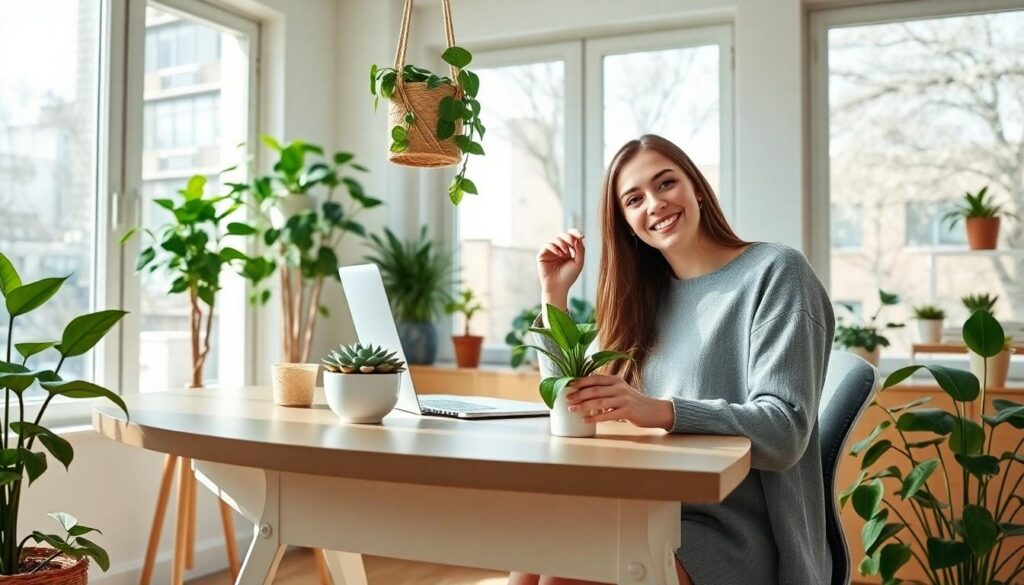Transforming your home office with plants isn’t just about aesthetics—it’s about creating a productive, calming environment where creativity thrives. From air-purifying properties to stress reduction benefits, indoor plants offer much more than simply filling empty spaces. We’ve gathered the most effective plant decor ideas to elevate your workspace while boosting your wellbeing.
Whether you’re working with a spacious dedicated room or a compact corner desk, there’s a perfect plant solution waiting for you. We’ll explore low-maintenance options for busy professionals, statement plants for video call backdrops, and clever hanging arrangements that save precious desk space. Ready to breathe life into your home office? These plant decor ideas will help you create an inspiring workspace that nurtures both your career and your wellbeing.
10 Best Plant Decor Ideas for Home Office Spaces
1. Desktop Succulent Arrangements
Small succulent arrangements are perfect for limited desk space while adding a touch of nature to your immediate workspace. These low-maintenance plants thrive with minimal attention, making them ideal companions for busy professionals. Arrange 3-5 different succulent varieties in a stylish container to create visual interest without overwhelming your desk. Their compact size ensures they won’t interfere with your essential work items or electronics.
2. Hanging Plant Displays
Maximize your vertical space with hanging plants that add greenery without consuming valuable work surfaces. Macramé plant hangers bring a bohemian touch while suspending plants like pothos or spider plants near windows. Installing ceiling hooks or tension rods allows you to create a stunning overhead display that draws the eye upward and expands your visual space. Plants with trailing vines create a cascading effect that softens the office environment.
3. Bookshelf Plant Integration
Transform your office bookshelves by interspersing plants among books and office supplies for a balanced, sophisticated look. Alternating plant heights and textures creates visual rhythm across your shelving units. Small potted plants like ZZ plants or peace lilies bring life to these spaces without overtaking your literature or reference materials. Their presence breaks up the monotony of books and adds organic shapes to otherwise linear arrangements.
4. Statement Floor Plants
Large floor plants serve as stunning focal points that anchor your home office design scheme. Position a fiddle leaf fig or monstera in an empty corner to fill awkward spaces with lush greenery. Their substantial size makes an immediate impact during video calls without requiring desk space. Placing these statement pieces in decorative planters that complement your office color scheme elevates the entire room’s aesthetic.
5. Vertical Garden Walls
Living walls transform plain office walls into breathtaking green features that serve as natural art pieces. These installations can be as simple as a few wall-mounted planters or as elaborate as full-coverage systems with built-in irrigation. Plants like ferns, pothos, and philodendrons adapt well to vertical growing conditions. Their textured foliage creates a ever-changing visual element that improves acoustics while improving air quality.
6. Floating Window Shelves
Window-adjacent shelving offers the perfect spot for light-loving plants while maximizing natural illumination. Installing narrow floating shelves at varying heights creates a customized plant display that catches sunlight. Small herbs and sun-loving plants thrive in these locations, allowing you to cultivate both beauty and useful plants. Their proximity to windows ensures they receive adequate light without blocking your view or natural brightness.
7. Desk Partition Plants
Natural dividers made from strategically placed plants help define workspace boundaries in open-concept home offices. Bamboo, tall grasses, or bushy plants create soft barriers without constructing actual walls. These living partitions absorb sound and reduce echoes while providing visual separation. Arranging plants of varying heights produces a natural-looking boundary that feels less rigid than traditional office dividers.
8. Terrarium Workstation Accents
Glass terrariums bring miniature ecosystems to your workspace with minimal maintenance requirements. These self-contained plant displays create humidity for moisture-loving plants without affecting your paperwork or electronics. Placing small terrariums near monitors or desk corners adds visual interest at eye level. Their enclosed environment requires infrequent watering, making them perfect for professionals who might forget regular plant care.
9. Seasonal Rotating Plant Displays
Refresh your office environment by switching decorative plants according to seasons or project cycles. Flowering plants during spring months bring color and inspiration, while sturdier evergreens provide stability during winter. This rotation system prevents visual monotony and allows you to experiment with different plant varieties. Designating a exact area for these changing displays helps maintain overall office organization while accommodating new botanical additions.
10. Minimalist Air Plant Arrangements
Air plants offer striking visual appeal without requiring soil or conventional containers, perfect for clean, minimalist workspaces. These versatile plants can be displayed in glass vessels, mounted on walls, or arranged on small stands without creating mess. Their unusual forms serve as conversation starters during video meetings while demanding minimal care. Simply mist these plants weekly to maintain their health and distinctive appearance.
Creating a Vertical Garden Wall for Focus and Productivity
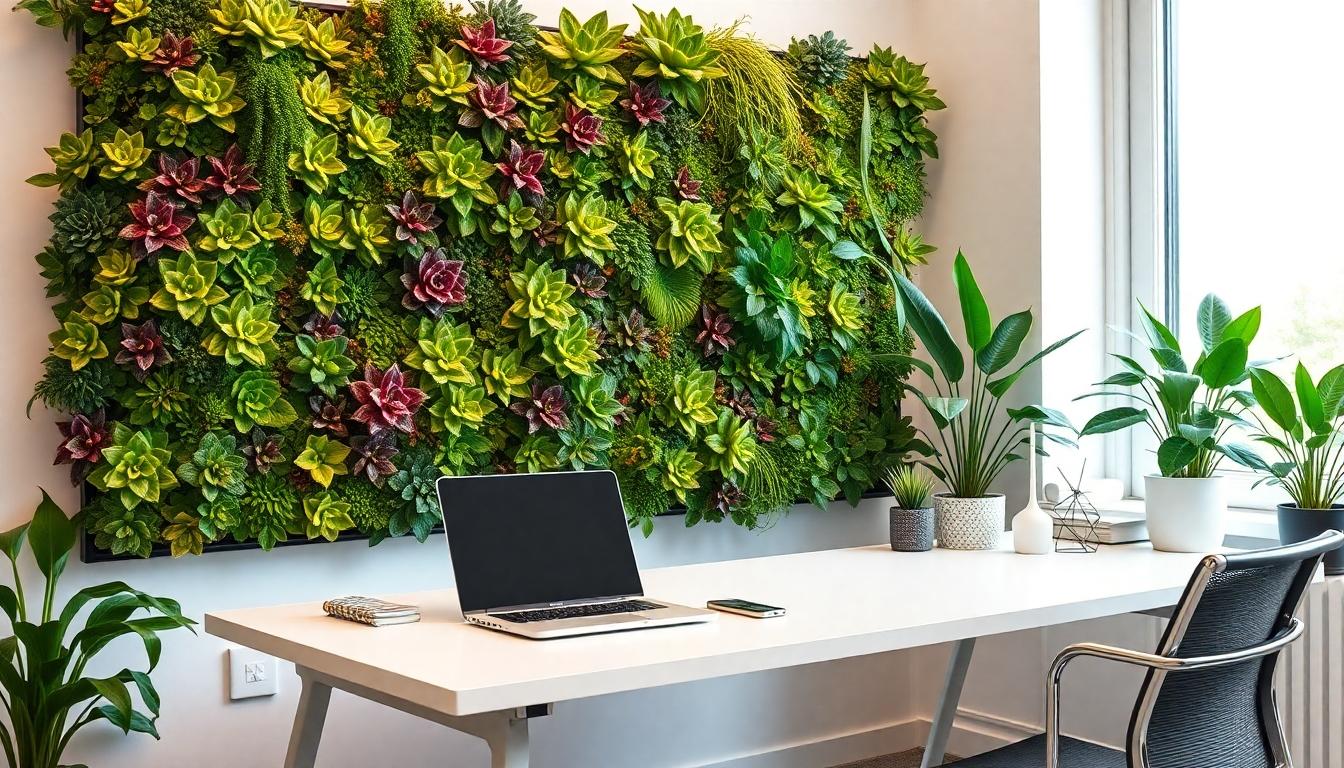
A vertical garden wall isn’t just a stunning visual element for your home office—it’s a productivity powerhouse. Research shows these living walls absorb up to 41% more sound than standard walls, creating a quieter, more focused workspace while improving your productivity by up to 15%.
Choosing the Right Plants for Your Living Wall
Selecting appropriate plants is crucial for a thriving living wall in your home office. Succulents make excellent choices due to their minimal maintenance requirements and ability to withstand varying conditions. Air Plants offer incredible versatility as they don’t require soil, making them perfect for creative wall displays. For offices with limited natural light, consider Pothos or Snake Plants, which flourish even in low-light environments. Group plants with similar moisture needs together to simplify your watering routine and prevent over or under-watering issues. The aesthetic appeal of your vertical garden depends largely on thoughtful plant selection that complements your office color scheme and design elements.
DIY Installation Tips for Small Spaces
Maximize your vertical space by utilizing wall-mounted systems that keep your floor area clear and functional. Installing a modular planter system allows for easy rearrangement as your office needs change or your plants grow. Consider implementing a self-watering system, which can reduce water usage by up to 80% while ensuring your plants remain healthy even during busy workweeks. Position your living wall where it creates maximum visual impact without interfering with your daily workflow. Pre-plan your design by sketching the layout before installation to avoid unnecessary holes or adjustments. Use lightweight materials that won’t damage your walls, especially important for renters or temporary office spaces. Proper lighting installation ensures your plants thrive year-round, regardless of natural light availability in your workspace.
Styling Your Desk with Low-Maintenance Succulents
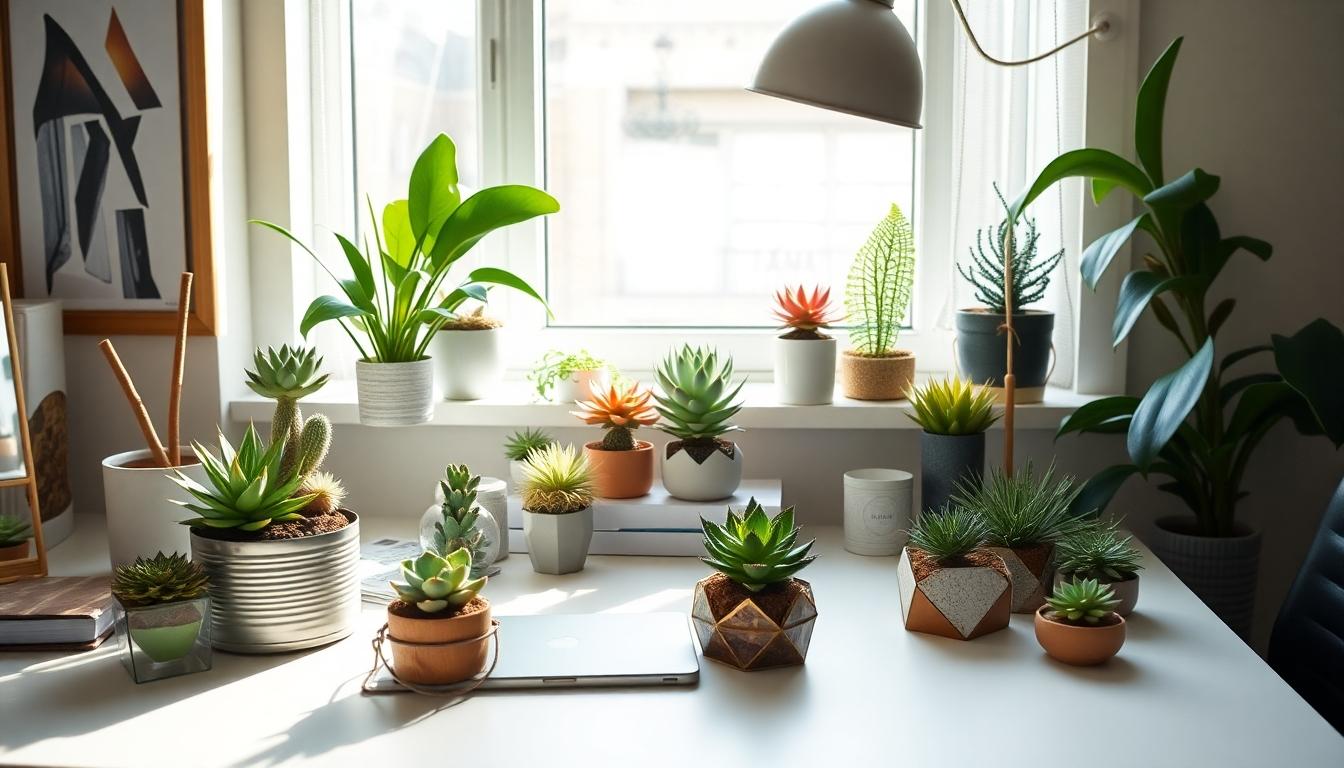
Succulents offer the perfect blend of style and practicality for home office spaces where maintenance time might be limited. These resilient plants bring natural elements to your workspace without demanding constant attention.
Miniature Desktop Gardens in Unusual Containers
Creating miniature desktop gardens in unexpected containers adds personality and creative flair to your home office. Repurposed items like teacups, vintage tins, or geometric terrariums make excellent homes for small succulent arrangements. Well-draining soil forms the foundation for these micro gardens, where varieties such as haworthia or sedum thrive in compact spaces. For a truly maintenance-free option, artificial succulent arrangements in these unique containers provide similar visual appeal without any watering schedule. These miniature gardens work particularly well on side tables or desk corners where they can serve as conversation starters during video meetings.
Air-Purifying Succulents for Better Concentration
While succulents aren’t typically known as top air purifiers, certain varieties contribute positively to your workspace environment. Aloe vera stands out among succulents for its potential air-cleaning properties, making it a practical addition to your desk. Pairing these hardy plants with more powerful air purifiers like snake plants or pothos creates an effective combination that helps reduce indoor pollutants and potentially enhances focus during work hours. For offices with limited natural light, faux succulents provide the aesthetic benefits without the light requirements. Placing these air-improving plants near your primary work area maximizes their benefit, creating a cleaner breathing space that supports longer periods of concentration.
When selecting containers, match your office aesthetic by choosing modern concrete pots for minimalist spaces or colorful ceramics to add vibrant accents. Live succulents require a sunny spot near windows, though LED grow lights offer an alternative for darker spaces. Most succulents need watering only every two weeks, while their artificial counterparts just need occasional dusting to maintain their fresh appearance. Compact arrangements measuring 6-8 inches work best for standard desks, ensuring they enhance rather than overwhelm your workspace.
Hanging Plants to Maximize Limited Office Space
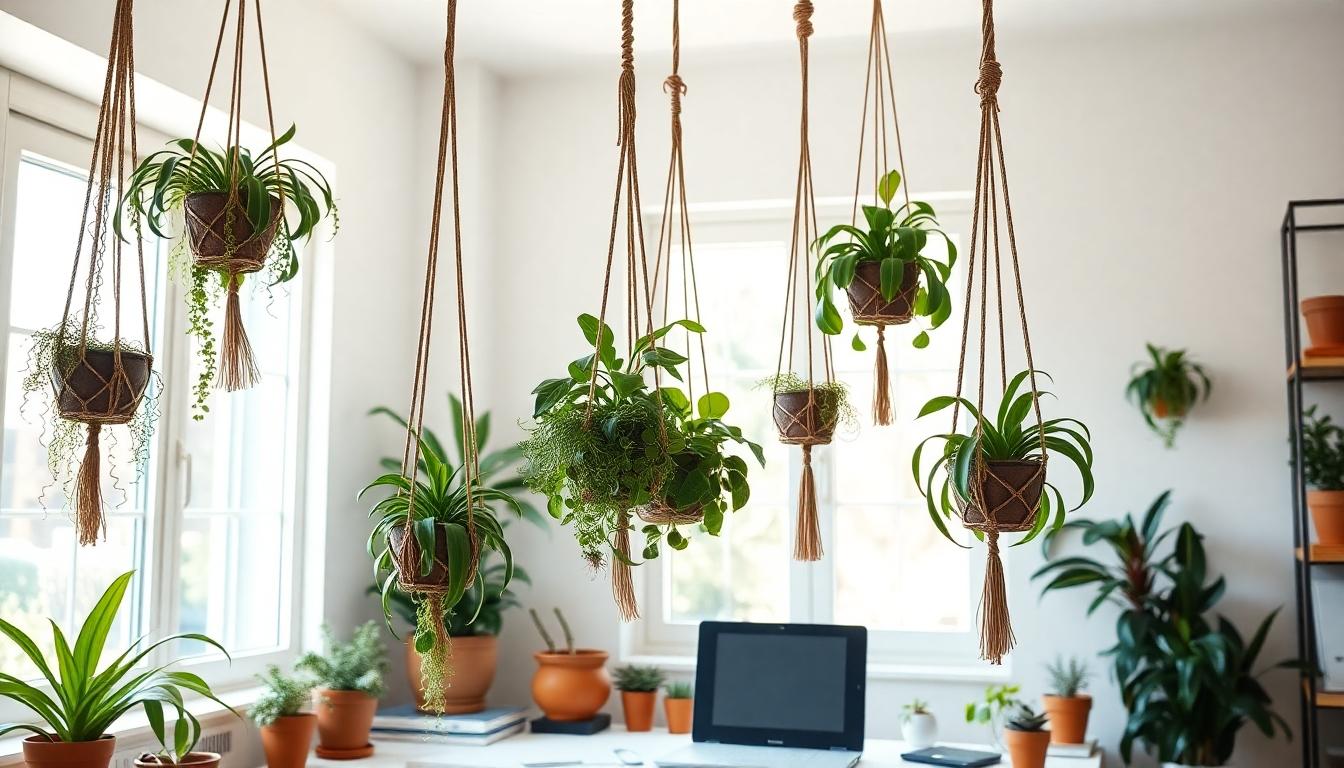
Hanging plants offer the perfect solution for home offices where desk and floor space is at a premium. These elevated greenery displays not only free up valuable workspace but also improve air quality and add visual interest to your office environment.
Macramé Hangers for Bohemian Office Vibes
Macramé plant hangers bring texture and artisanal charm to any home office space. We love pairing terracotta pots with handmade macramé holders for displaying small trailing species like succulents or pothos. These bohemian-inspired hangers enhance your décor while efficiently conserving surface area in compact workspaces. Position them near windows or in empty corners to add visual warmth without requiring permanent structural modifications. The natural fibers and intricate knotwork create an inviting atmosphere that softens the typical office environment, making your workspace feel more personalized and creative.
Best Trailing Plants for Hanging Displays
Spider Plants top our list of excellent hanging options with their variegated foliage and impressive air-purifying capabilities. They thrive in indirect light conditions and require minimal watering, producing cascading “pups” that create beautiful layered greenery. Devil’s Ivy deserves consideration for its heart-shaped leaves and remarkable tolerance for low light and irregular watering schedules. Kangaroo Ferns offer stunning arching fronds that create ever-changing movement in your office space while tolerating low-to-medium light conditions with occasional misting. String of Pearls plants provide drought-tolerant options with their distinctive trailing stems, perfect for bright indirect light positions in your home office.
For installation, use ceiling hooks, wall brackets, or curtain rods with S-hooks to suspend your planters without occupying valuable desk space. We recommend choosing lightweight pots with proper drainage to prevent overwatering issues and water damage to your office surfaces. Curtain rods offer particularly flexible positioning options, allowing you to create modular plant arrangements that can be adjusted as your office needs change.
Incorporating Large Statement Plants for Empty Corners
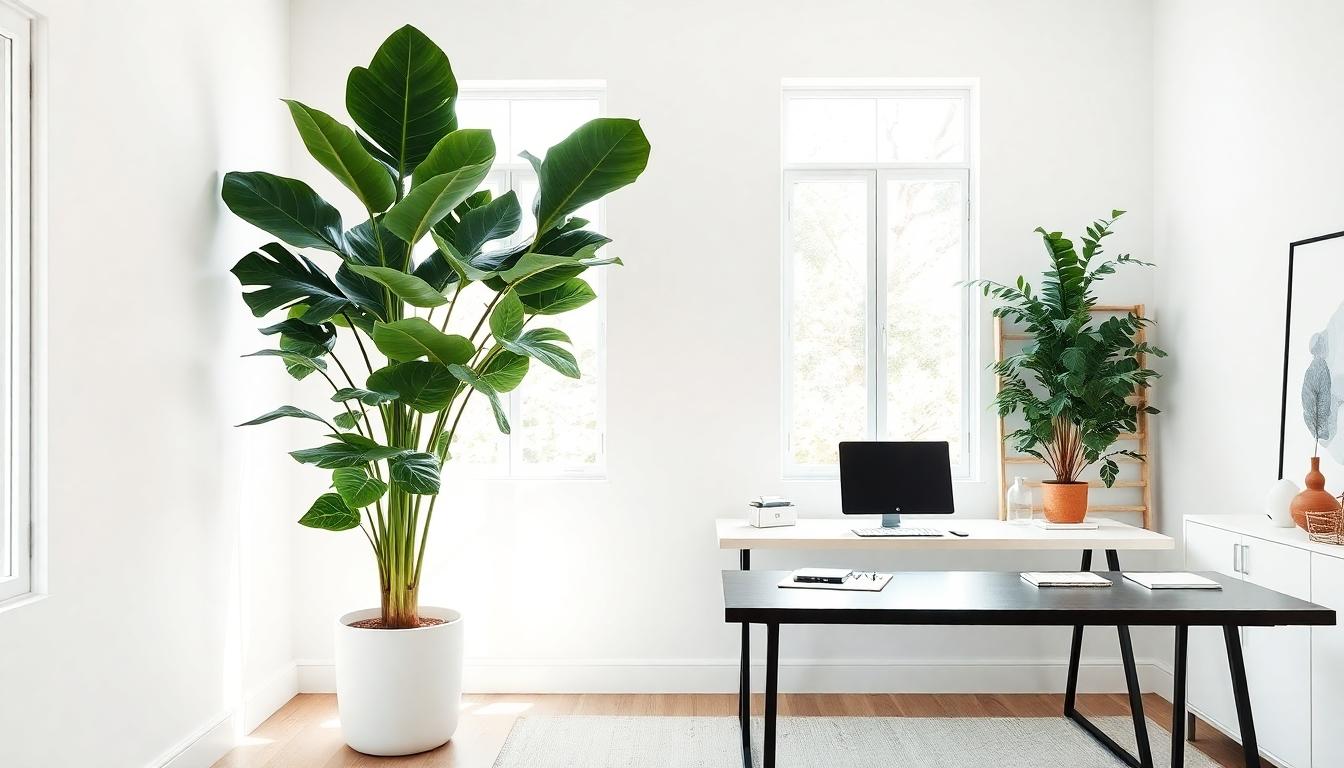
Large statement plants can transform those awkward empty corners in your home office into stunning focal points while maximizing your workspace’s aesthetic appeal. These impressive botanical additions not only fill unused spaces but also bring life and energy to your work environment.
Choosing the Right Floor Plants for Your Lighting Conditions
Selecting appropriate floor plants based on your office’s lighting conditions ensures your green companions will thrive. For low light corners, Snake Plants and ZZ Plants make excellent choices as they tolerate minimal light and can survive with irregular watering schedules. These resilient plants maintain their attractive appearance even when neglected occasionally.
In spaces with moderate to bright indirect light, consider adding a Monstera Deliciosa with its distinctive perforated leaves. The Bird of Paradise thrives in bright, filtered light conditions and adds a touch of tropical elegance to any workspace. Both plants create dramatic visual impact while requiring relatively simple care routines.
For office corners that receive direct sunlight, Cacti and Yucca plants are perfect options. These sun-loving varieties adapt well to intense light and low humidity environments, making them ideal for sunny home offices. Dragon Trees can reach impressive heights up to 3 meters, require minimal watering, and their sword-shaped leaves add wonderful structural interest to any corner.
How to Style Fig Trees and Monstera Plants in Your Workspace
Fiddle Leaf Figs create instant impact when positioned in corners with bright, indirect light. Their large, glossy leaves form a natural focal point that draws the eye upward, improving your perception of space. Position these statement plants near east-facing windows for optimal growth.
When selecting pots for your statement plants, consider neutral-toned, minimalist containers to complement modern office decor. Terracotta pots offer a more rustic aesthetic that works well in warm-toned spaces. The container should enhance rather than compete with your plant’s natural beauty.
Create visual interest by clustering smaller plants beneath larger specimens. Pothos or Spider Plants work wonderfully as companion plants for Monstera or Fig trees, creating layered, textured displays that add depth to your corner arrangements. This strategic grouping mimics natural plant communities while maximizing your green footprint.
For Monstera plants, which benefit from humid conditions, consider placement near a humidifier or in naturally humid corners of your office. Palms, such as Areca or Kentia varieties, can effectively define workspace boundaries and enhance privacy in open-plan home offices. Their feathery fronds create a gentle screen without completely blocking light or views.
Color coordination between your planters and office furniture creates a cohesive look. Match your plant containers to desk accessories, chair colors, or decorative elements to tie your entire workspace design together for a professionally styled appearance.
Arranging a Window Sill Plant Collection for Natural Light
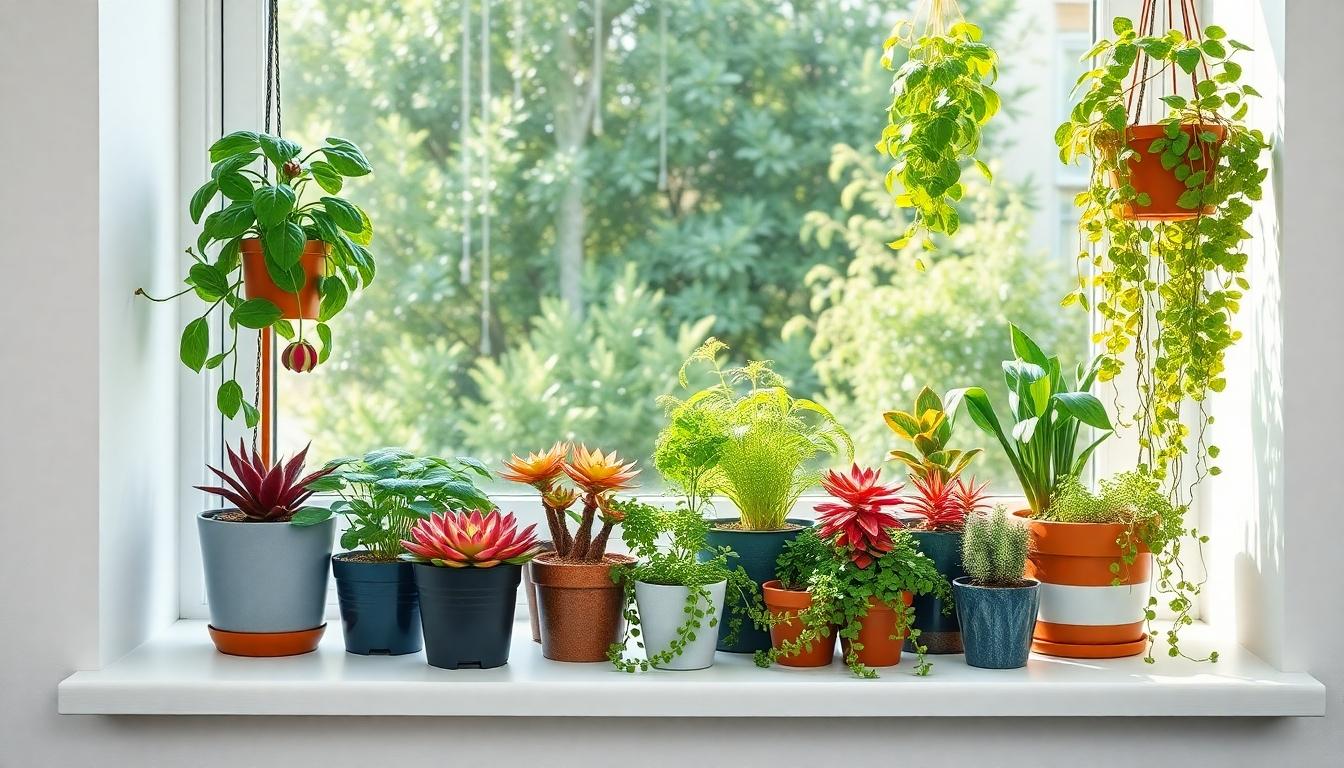
Window sills offer prime real estate for plants in a home office, combining functionality with beauty by maximizing natural light exposure. Creating a thoughtful arrangement can transform this often-underutilized space into a thriving mini garden.
Use Window Space Effectively
Window sills provide the perfect spot for light-loving plants that can enhance your workspace atmosphere. Succulents and herbs thrive particularly well in these sunny locations, making the most of both the natural light and limited space. Arranging smaller pots along the sill creates an organized display that doesn’t overwhelm your office environment.
Mix Plant Heights for Visual Interest
Combining plants of varying heights creates dimension and visual appeal in your window display. Taller specimens at the back allow shorter plants to receive adequate light while creating a layered effect. This strategic arrangement not only looks aesthetically pleasing but also optimizes how light reaches each plant in your collection.
Incorporate Hanging Plants to Maximize Space
Installing a curtain rod above your window or using macrame hangers allows you to suspend plants, creating a multi-level display. Hanging plants receive abundant sunlight while freeing up valuable sill space for other varieties. This vertical gardening approach works exceptionally well for cascading species that can create a natural curtain effect.
Herbs That Thrive on Window Sills While Adding Fragrance
Office window sills offer the perfect environment for growing aromatic herbs that can refresh your workspace with natural scents. Cultivating these fragrant plants provides both visual appeal and practical benefits as they infuse your home office with subtle, pleasant aromas.
Basil thrives in sunny window locations and releases its distinctive aromatic fragrance throughout your workspace. This culinary herb not only smells wonderful but also provides fresh leaves for your lunch breaks. Regular harvesting encourages bushier growth, improving both its appearance and fragrance output.
Mint performs excellently as a window sill plant with its invigorating scent that can boost alertness during long work sessions. Its hardy nature makes it forgiving for busy professionals who might occasionally forget to water. Mint’s spreading tendency works well in individual containers where it can be contained appropriately.
Chives offer a mild onion fragrance and distinctive vertical growth that adds textural variety to your window display. These easy-to-grow herbs require minimal maintenance while providing both visual interest and culinary benefits. Their purple pom-pom blooms add unexpected color to your office environment when allowed to flower.
Creating a Cohesive Display with Varying Heights
Building a visually appealing plant arrangement involves thoughtful consideration of height variations and placement strategies. Effective displays maintain balance while introducing different levels of greenery throughout your office space.
Cluster Charm works beautifully by grouping smaller plants on shelves or desks to create focused areas of greenery. Small collections of 3-5 plants with complementary needs create mini ecosystems that add life without overwhelming your workspace. This approach maintains a productive environment while still introducing beneficial plant elements.
Floor Flourish utilizes strategic placement of taller potted specimens to define spaces and enhance privacy within your home office. Large statement plants like fiddle leaf figs or snake plants can serve as natural room dividers. Their substantial presence adds architectural interest while maintaining the professional atmosphere necessary for productive work.
Match Decor Elements by selecting containers that complement your existing office aesthetic. Coordinating pot colors, materials, and styles with your furniture and accessories creates a cohesive design language. This intentional approach ensures your plant collection enhances rather than competes with your overall office design scheme.
Using Shelving Units as Dedicated Plant Displays
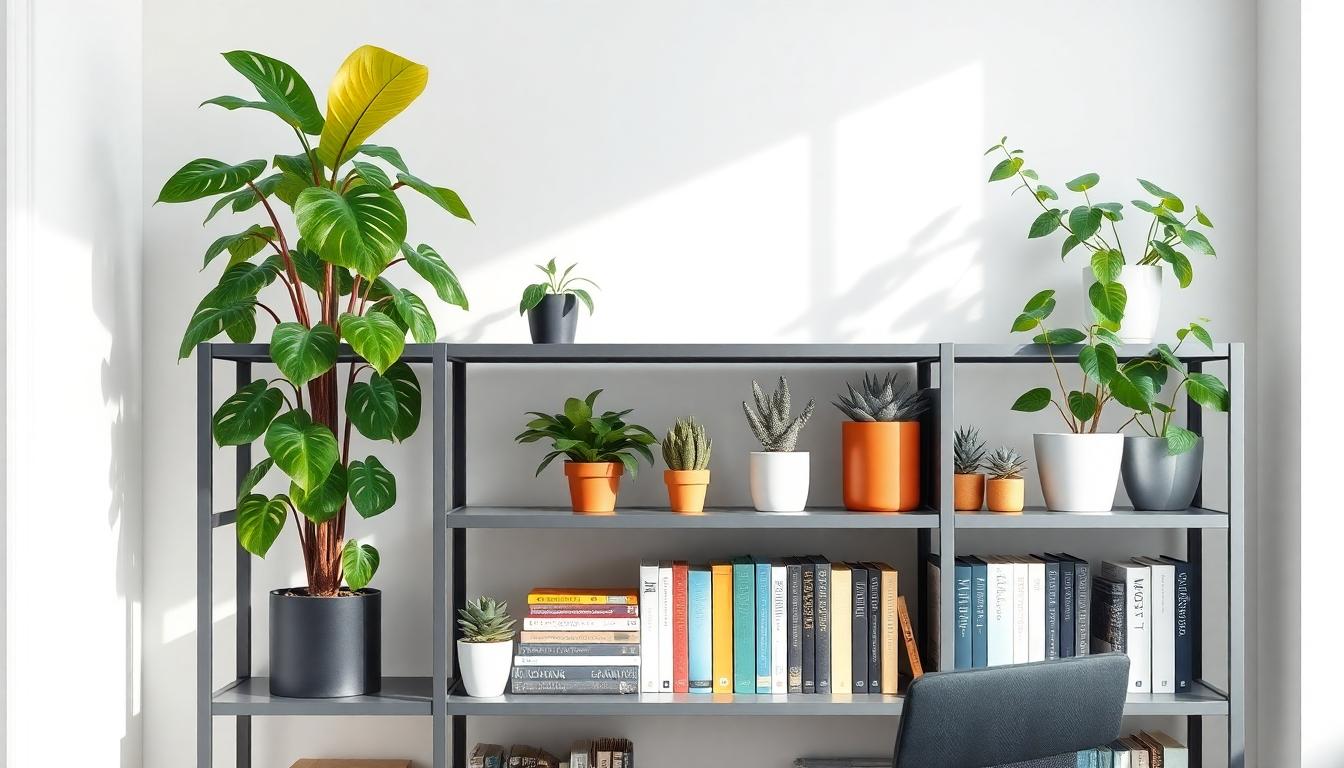
Shelving units offer an ideal solution for displaying plants in your home office, maximizing vertical space while creating an organized and aesthetically pleasing environment. By dedicating shelves to your green friends, you’ll add life to your workspace without sacrificing valuable desk or floor area.
Plant Shelf Styling Tips for Video Conference Backgrounds
Creating the perfect plant backdrop for your video calls requires strategic arrangement and thoughtful styling. A minimalist approach works best for professional settings, so select just a few statement plants rather than overwhelming your background with greenery. Position taller plants at varying heights to create visual interest without appearing cluttered. Coordinate your plant containers with your existing office color scheme to maintain a cohesive look that appears intentional rather than haphazard. Consider the lighting conditions as well—plants placed in your video background should be in suitable light to maintain their health and appearance during long workdays.
Combining Books and Plants for Intellectual Appeal
Integrating plants with books creates a sophisticated and intellectually stimulating atmosphere in your home office. Bookcase incorporation works particularly well—place trailing plants on top shelves to create cascading greenery, or position compact plants between book sections as natural dividers. This combination evokes a scholarly yet organic environment that enhances concentration and creativity. Harmony between these elements is crucial, so try matching plant pot colors with book covers or your shelf design for a unified look. Small potted plants can serve as decorative bookends, while larger specimens provide focal points among your literary collection. This thoughtful integration of nature and knowledge transforms an ordinary office into a space that nurtures both intellectual pursuits and biophilic connections.
Integrating Terrariums for Low-Maintenance Greenery
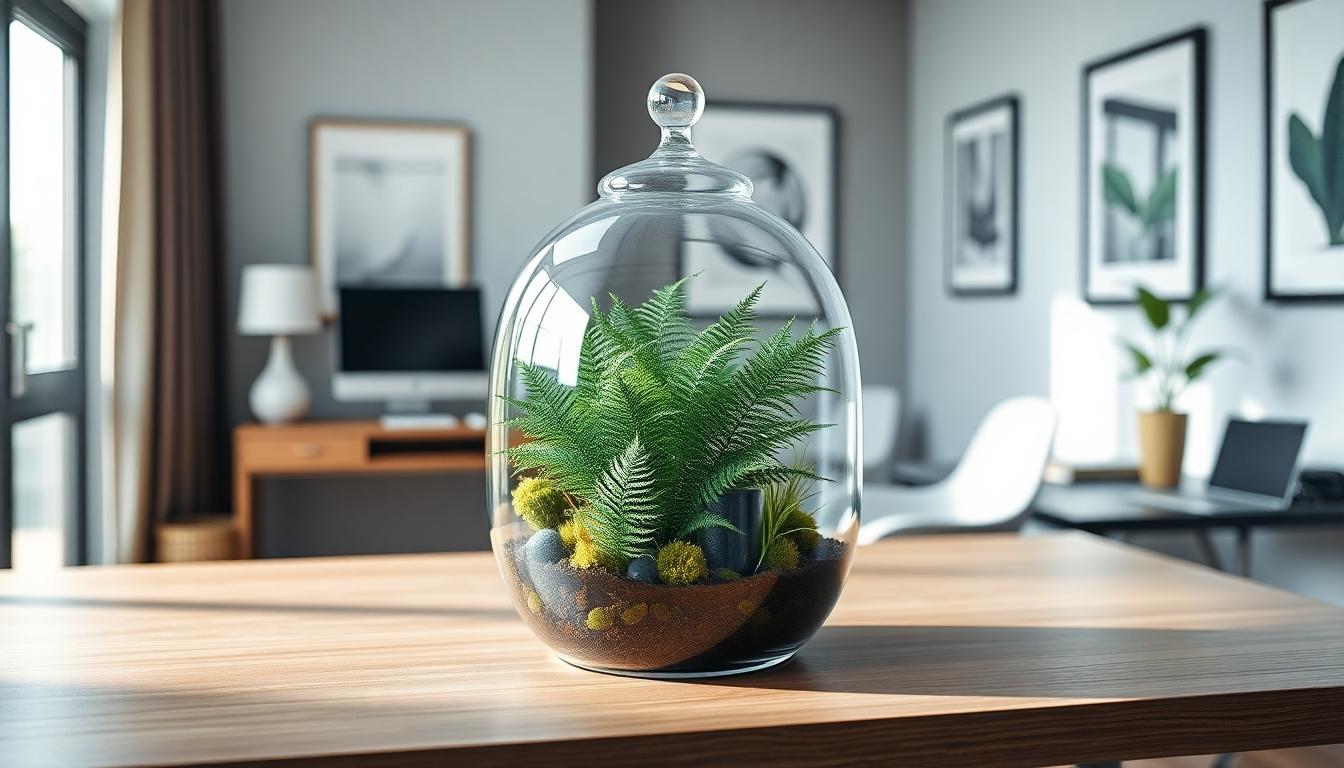
Terrariums offer an elegant solution for bringing nature into your workspace without the demands of traditional plant care. These miniature ecosystems require minimal attention while adding sophisticated visual appeal to any home office setting.
Closed Terrariums for Busy Professionals
Closed terrariums excel in low-light home office environments, making them perfect for spaces with limited natural sunlight. They function as self-sustaining ecosystems that recycle moisture through condensation cycles, requiring watering only every 2-4 weeks. Ferns, moss, and humidity-loving plants like nerve plants thrive in these enclosed environments. When setting up your closed terrarium, ensure the container allows adequate airflow to prevent mold growth. Orchids can also flourish beautifully in terrariums designed with “false bottoms” that provide proper drainage while maintaining the humidity these delicate plants crave. For desk placement, tabletop designs such as Glasseam Bud Bulb Vases or Invaldor Desktop Glass Plant Terrarium combine functionality with aesthetic appeal through their elegant glass containers and wooden stands.
Creating Custom Themed Terrariums for Inspiration
Custom themed terrariums transform ordinary plant decor into motivational workspace elements that reflect your personal style. Minimalist designs featuring geometric glass containers with single air plants or succulents create clean, contemporary focal points for modern home offices. Rustic-themed options incorporate wooden-framed terrariums, like Invaldor’s designs, paired with cascading plants such as pothos or ivy that add warmth and organic texture. Vintage enthusiasts can repurpose antique glassware or classic containers filled with mixed foliage for a nostalgic touch that complements traditional office decor. Artisanal platforms like Etsy offer handcrafted terrarium landscapes with miniature themed setups—from desert scenes with tiny cacti to lush tropical arrangements—that spark creativity during long workdays. When selecting your terrarium container, consider the needs of your chosen plants: closed systems work best for humidity-sensitive species while open designs suit cacti and succulents. Layer materials properly (gravel, activated charcoal, soil) to ensure effective drainage and create a sustainable microenvironment that thrives with minimal maintenance.
Seasonal Plant Rotation to Keep Your Office Fresh

Seasonal plant rotation helps maintain a fresh and vibrant home office environment throughout the year. Changing your greenery with the seasons not only keeps your workspace visually interesting but also ensures your plants thrive in varying conditions.
Spring and Summer Office Plant Collections
During the warmer months, your home office can benefit from lush, vibrant plants that flourish in increased light and humidity. Fiddle Leaf Figs stand out as popular choices for spring and summer due to their natural beauty and ability to thrive indoors when temperatures are moderate. These statement plants can become the focal point of your workspace, adding a touch of tropical elegance during the growing season.
Dragon Trees offer another excellent option for the warmer months with their striking, architectural leaves and relatively low-maintenance requirements. Their dramatic silhouette creates visual interest without demanding excessive attention, making them perfect for busy professionals during the productive summer months. Consider placing these near east or west-facing windows where they’ll receive bright, indirect light throughout the spring and summer days.
Fall and Winter Plant Care for Home Offices
As daylight decreases and indoor heating systems activate, your plant selection should adapt accordingly. Succulents prove ideal for fall and winter office environments since they require less watering during these colder, drier months. Their ability to thrive in low-light conditions makes them perfect companions when natural sunlight becomes limited during shorter winter days.
Spider Plants deserve special consideration for the colder seasons as they can thrive with minimal maintenance in cooler conditions. These resilient plants continue to purify your air while requiring less attention during the winter months. Their adaptability to indoor environments makes them reliable year-round companions that won’t suffer from seasonal changes in temperature and humidity levels.
Incorporating Plants into Your Office Storage Solutions

Maximizing your home office space while adding greenery doesn’t have to be complicated. We can help you transform ordinary storage answers into vibrant plant displays that enhance both functionality and aesthetics.
Hanging Plants for Vertical Space
Hanging plants offer an excellent solution for freeing up valuable desk space while adding visual interest to your home office. By using ceiling hooks, wall brackets, or macramé hangers, you’ll create an eye-catching display that keeps your workspace clutter-free. These suspended arrangements add a bohemian touch that softens the often rigid lines of office furniture. Popular hanging options include Spider Plants, Devil’s Ivy, and String of Pearls, which create cascading greenery above your workspace.
Vertical Shelves for Plant Displays
Vertical shelving units provide the perfect opportunity to maximize your wall space while showcasing your plant collection. Indoor plant shelves can be installed in various configurations to suit your exact office layout, creating a striking visual element that draws the eye upward. These shelves allow you to arrange plants at different heights, creating depth and dimension in your office design. Floating shelves work particularly well for smaller spaces, while ladder-style shelving offers a trendy solution for displaying multiple plants in a compact footprint.
Bookcase Integration Techniques
Bookcases offer prime real estate for incorporating plants into your office without sacrificing functionality. Place small plants between books and office supplies to create visual breaks in your shelving arrangement. This integration method allows the greenery to complement rather than compete with your work essentials. Alternating books with plants creates a balanced, intentional look that transforms an ordinary bookcase into a living display. Consider positioning plants at varying depths on the shelves to create a more ever-changing and less rigid appearance.
Plants That Thrive in Bookcase Environments
Small succulents prove ideal for bookcase settings due to their minimal care requirements and compact size. Their ability to thrive in low light conditions makes them perfect companions for your books and office materials. Air plants eliminate the need for soil, making them exceptionally versatile for bookcase styling without risking damage to important documents or books. These unusual specimens can be placed directly among books or in small decorative holders. Trailing plants like English Ivy or Pothos excel when positioned on higher shelves, creating a cascading effect that softens the structured look of bookcases. Their ability to grow downward adds movement and life to static storage answers.
Creative Ways to Integrate Plants with Office Supplies
Clustered desk plants introduce greenery into your workspace without overwhelming it. Grouping small plants creates a mini garden effect that enhances your office ambiance while keeping your working area functional. Try placing them near but not interfering with frequently used items. Matched decor creates cohesion when you select plant pots that complement your existing office accessories. Coordinating colors and materials between your planters and desk organizers establishes a unified and thoughtfully designed workspace. Natural partitions formed by taller plants like palms or Dragon Trees serve dual purposes, dividing different areas of your office while adding substantial greenery. These living dividers provide privacy without the closed-in feeling of solid partitions, maintaining an open atmosphere while defining separate zones for different activities.
Creating a Harmonious Plant-Based Home Office Environment
Transforming your home office with plants isn’t just a design choice—it’s an investment in your wellbeing and productivity. The perfect plant setup balances aesthetics with functionality while creating a space that inspires creativity and focus.
Whether you’ve opted for hanging arrangements to save space vertical gardens to absorb noise or seasonal displays to keep your environment fresh each solution offers unique benefits customized to your working style.
Remember that the best plant decor evolves with you. Start small with desktop succulents or air plants then expand as your confidence grows. Your green office companions will reward you with cleaner air improved focus and a workspace that feels distinctly alive and personal.
By thoughtfully integrating nature into your daily work environment you’ve created more than just a beautiful office—you’ve designed a sanctuary that supports both your career goals and personal wellness.
Frequently Asked Questions
What are the main benefits of having plants in a home office?
Plants in home offices improve air quality by filtering toxins, reduce stress levels, and boost productivity. Research shows they can increase creativity by up to 15% and reduce stress by 37%. Beyond aesthetics, they add humidity to dry indoor environments, absorb noise for a quieter workspace, and create a more professional backdrop for video calls. They’re both functional and beautiful additions to any work environment.
Which plants are best for low-light home office spaces?
Snake Plants, ZZ Plants, and Pothos are excellent choices for low-light offices. These hardy varieties thrive with minimal sunlight and require infrequent watering. Peace Lilies and Chinese Evergreens also perform well in dim conditions while purifying air. Spider Plants are another adaptable option that can survive in less-than-ideal lighting situations while adding visual interest with their arching leaves.
How often should I water my office plants?
Watering needs vary by plant type, but most office plants require watering once every 1-2 weeks. Succulents need water only when soil is completely dry (every 2-3 weeks), while tropical plants may need weekly watering. Instead of following a strict schedule, check soil moisture by inserting your finger about an inch deep—if it feels dry, it’s time to water. Reduce frequency during winter months when plant growth slows.
What are the best plants for improving air quality?
Peace Lilies, Snake Plants, Spider Plants, and Boston Ferns are top performers for air purification. These plants effectively remove common indoor pollutants like formaldehyde, benzene, and trichloroethylene. Areca Palms and English Ivy are also excellent choices, with NASA research confirming their air-cleaning abilities. For maximum benefit, incorporate several different varieties and aim for at least one medium-sized plant per 100 square feet of office space.
How can I incorporate plants if I have limited desk space?
Use vertical space with hanging planters, wall-mounted pots, or macramé holders. Consider mini succulents or air plants that require minimal surface area. Floating shelves installed above your desk create display space without consuming valuable work area. Window sills offer prime real estate for small plants, while magnetic planters can attach to metal surfaces. Alternatively, use a plant stand next to your desk rather than on it.
Are there plants that help reduce stress during work hours?
Lavender, jasmine, and rosemary release calming scents that reduce anxiety and improve focus. Studies show that simply viewing greenery for 3-5 minutes can lower stress hormones. Snake Plants and Aloe Vera release oxygen at night, improving sleep quality that affects next-day stress levels. Peace Lilies create a sense of tranquility, while caring for any plant provides mindful breaks during intense work periods. Even small desk plants offer significant psychological benefits.
How do I create a vertical garden wall in my home office?
Start with a wall-mounted frame system or pocket planter designed for vertical gardens. Choose appropriate plants like ferns, pothos, succulents, or air plants based on your lighting conditions. Install a moisture barrier to protect your wall if using a DIY approach. Consider a self-watering system for maintenance ease. Begin with a small installation and expand as you gain confidence. Position your living wall where it receives adequate light but won’t be damaged by heat.
What are the best hanging plants for home offices?
Spider Plants, Pothos (Devil’s Ivy), and String of Pearls are excellent trailing options that thrive in hanging planters. Philodendron and Boston Ferns add lush greenery while purifying air. For flowering options, consider Lipstick Plants or Trailing Begonias. These plants create visual interest without consuming desk space. Most require moderate indirect light and weekly watering. Macramé hangers add stylish texture while displaying these cascading plants effectively.
How can terrariums enhance a home office environment?
Terrariums create self-contained ecosystems that require minimal maintenance—perfect for busy professionals. They add visual interest while taking up little space and can be customized to match any office aesthetic. Closed terrariums create their own moisture cycle, needing attention only every 4-6 weeks. They serve as conversation starters during video calls and can incorporate themes that inspire creativity. The enclosed environment also helps maintain humidity around your workspace.
What’s the best way to rotate seasonal plants in a home office?
Plan quarterly rotations aligned with the seasons, swapping 2-3 plants each time for manageable change. For spring/summer, introduce colorful flowering plants and larger leafy varieties that thrive in increased light. In fall/winter, transition to hardier species like succulents and cacti that need less water and light. Maintain a few “anchor plants” year-round for consistency while rotating accent plants. This approach keeps your space visually fresh while ensuring plants grow in optimal conditions.
How do I incorporate statement floor plants in my home office?
Position large floor plants like Fiddle Leaf Figs or Monstera in empty corners or next to furniture to create focal points. Ensure they receive appropriate light—most statement plants need moderate to bright indirect light. Select containers that complement your office color scheme and are proportionate to plant size. Elevate plants on stands for added height and visual interest. For balance, cluster smaller plants beneath larger specimens to create layered displays that enhance your workspace’s professional appeal.
Can plants really improve productivity in a home office?
Yes, research shows plants can increase productivity by up to 15%. The presence of greenery improves concentration and attention span while reducing mental fatigue. Plants boost creativity by providing visual stimulation and subtle movement. They improve air quality by increasing oxygen levels and removing toxins, leading to better cognitive function. The simple act of caring for plants provides restorative mental breaks during work. Even a single desk plant can produce measurable improvements in focus and task performance.

